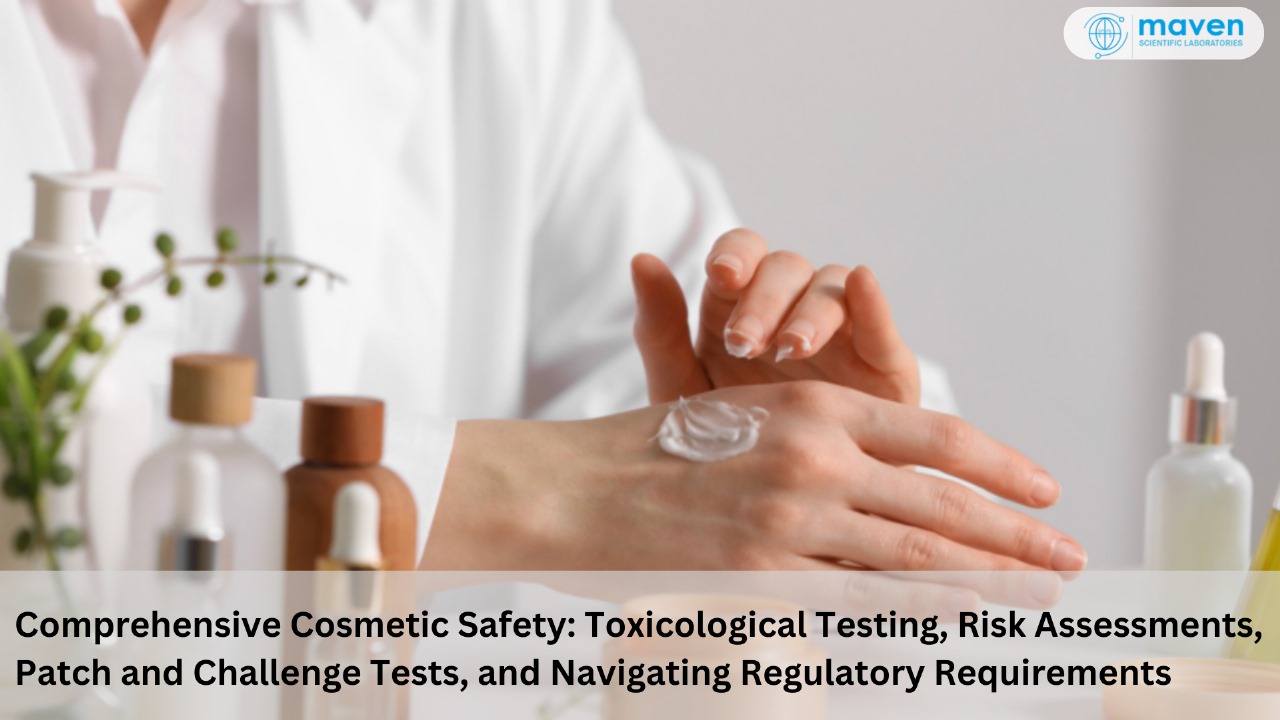Comprehensive Cosmetic Safety: Toxicological Testing, Risk Assessments, Patch and Challenge Tests, and Navigating Regulatory Requirements
November 08, 2024
Introduction
When purchasing cosmetics, whether moisturizer, shampoo, or makeup, consumers expect them to be safe and effective. To meet these expectations, cosmetic products undergo rigorous safety evaluations. Two essential tests in this process are the Challenge Test (Preservative Efficacy Test) and the Patch Test, both of which help ensure products are free from harmful microorganisms and won’t cause adverse skin reactions. In addition, comprehensive toxicological testing and risk assessments are critical to ensuring product safety in line with regulatory guidelines. In this blog, we’ll explore these tests, regulatory requirements, the role of toxicologists, and how Maven can support manufacturers in navigating these complex processes.
Regulatory Guidelines for Cosmetic Safety
Cosmetic regulations vary by region but generally mandate robust safety evaluations for all products before they reach consumers. Key regulatory frameworks include:
• EU’s Cosmetic Products Regulation (EC) No 1223/2009: Requires the Cosmetic Product Safety Report (CPSR) to confirm that cosmetics are safe for human health. This includes toxicological assessments of each ingredient.
• FDA Guidelines (U.S.): While the FDA does not require pre-market approval, it mandates that products be safe for consumer use. Manufacturers must ensure products are free from harmful microorganisms and are unlikely to cause adverse reactions.
• Other Global Standards: Many countries have specific guidelines for cosmetics. For example, Japan and South Korea have rigorous safety protocols, including toxicity assessments and allergen testing.
The Importance of Toxicological Testing and Risk Assessments
Beyond microbiological and dermatological testing, toxicological evaluations provide a deeper assessment of ingredient safety and product formulations. These assessments include:
• Toxicological Testing: Toxicologists analyze ingredients for potential toxic effects, ensuring they are safe at the intended concentration levels. Common tests include assessing skin irritation, sensitization, and allergenic potential.
• Toxicological Risk Assessments: Toxicologists evaluate the overall formulation's safety, focusing on possible risks from cumulative exposure to individual ingredients. They also determine safe usage levels, considering factors such as dermal absorption and the likelihood of systemic exposure.
Why Toxicological Testing and Risk Assessment Matter:
• Consumer Safety: Identifying and mitigating risks associated with product ingredients ensures safety for users, especially those with sensitive skin or allergies.
• Regulatory Compliance: These assessments are crucial for meeting legal requirements, as regulations mandate an evaluation of toxicity and cumulative exposure for all cosmetic products.
• Ingredient Safety Assurance: This process helps manufacturers ensure that their products are safe under normal and reasonably foreseeable conditions of use.
Key Cosmetic Tests and Their Role in Ensuring Safety
The Challenge Test and Patch Test play essential roles in cosmetic safety:
• Challenge Test: This microbiological test evaluates the product’s preservative system, ensuring it effectively prevents microbial growth throughout the product's shelf life. By exposing the product to common microorganisms, toxicologists assess whether preservatives maintain safe microbial levels under typical usage conditions.
• Patch Test: The Patch Test helps determine whether the product may cause skin irritation or allergic reactions. Toxicologists apply a small amount of product to the skin to observe any signs of redness or swelling. This test is especially important for products marketed as hypoallergenic or suitable for sensitive skin.
How Maven Supports Cosmetic Safety Testing and Compliance
Navigating regulatory requirements and conducting rigorous safety assessments can be daunting. Maven offers comprehensive support in safety testing, toxicological assessments, and compliance, helping manufacturers bring safe, high-quality cosmetics to the market.
• Toxicological Expertise: Maven’s team of certified toxicologists conducts detailed toxicological testing and risk assessments for cosmetics, analyzing ingredients and formulations for potential hazards and advising on safe concentrations.
• Challenge and Patch Testing: Maven assists with both Challenge and Patch Testing, ensuring products meet microbiological and dermatological safety standards. This includes designing testing protocols that align with regulatory guidelines.
• Regulatory Compliance Consulting: Maven stays updated on global cosmetic regulations, helping clients understand and meet the standards in regions like the EU, U.S., and Asia. Maven provides guidance on preparing the CPSR, ensuring all toxicological assessments and testing requirements are met.
• Customized Solutions: Maven provides tailored advice on improving formulations, identifying safe preservatives, and selecting suitable test methods. This helps clients minimize the risk of adverse reactions and enhance product appeal.
Conclusion
Challenge Testing, Patch Testing, and toxicological risk assessments are essential to ensure the safety and effectiveness of cosmetic products. With the support of Maven’s toxicological expertise and regulatory guidance, manufacturers can meet compliance requirements, enhance consumer safety, and build lasting trust in their products. In the competitive beauty industry, investing in rigorous safety testing not only fulfils regulatory obligations but also reinforces product quality, consumer trust, and brand reputation.
For more information on Comprehensive Cosmetic Safety and how Maven can support your Regulatory Requirements, please reach out to us at info@mavenrs.com or visit our website at www.mavenrs.com.


Post a comment